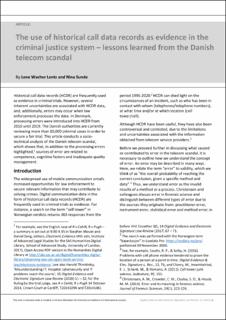The use of historical call data records as evidence in the criminal justice system: Lessons learned from the Danish telecom scandal
| dc.contributor.author | Lentz, Lene Wacher | |
| dc.contributor.author | Sunde, Nina | |
| dc.coverage.spatial | Denmark | en_US |
| dc.date.accessioned | 2020-12-16T10:54:40Z | |
| dc.date.available | 2020-12-16T10:54:40Z | |
| dc.date.issued | 2021 | |
| dc.identifier.issn | 1756-4611 | |
| dc.identifier.uri | https://hdl.handle.net/11250/2719778 | |
| dc.description.abstract | Historical call data records (HCDR) are frequently used as evidence in criminal trials. However, several inherent uncertainties are associated with HCDR data, and, additionally, errors may occur when law enforcement processes the data. In Denmark, processing errors were introduced into HCDR from 2010 until 2019. The Danish authorities are currently reviewing more than 10,000 criminal cases in order to secure a fair trial. This article conducts a socio-technical analysis of the Danish telecom scandal, which shows that, in addition to the processing errors highlighted,1 sources of error are related to competence, cognitive factors and inadequate quality management. | en_US |
| dc.language.iso | eng | en_US |
| dc.publisher | Pario Communications Ltd | en_US |
| dc.subject | politi | en_US |
| dc.subject | policing | en_US |
| dc.subject | etterforskning | en_US |
| dc.subject | investigation | en_US |
| dc.subject | call data | en_US |
| dc.subject | teledata | en_US |
| dc.subject | bevis | en_US |
| dc.subject | evidence | en_US |
| dc.subject | Danmark | en_US |
| dc.subject | Denmark | en_US |
| dc.title | The use of historical call data records as evidence in the criminal justice system: Lessons learned from the Danish telecom scandal | en_US |
| dc.type | Peer reviewed | en_US |
| dc.type | Journal article | en_US |
| dc.description.version | publishedVersion | en_US |
| dc.source.journal | Digital Evidence and Electronic Signature Law Review | en_US |
| dc.identifier.doi | https://doi.org/10.14296/deeslr.v18i0.5235 |
